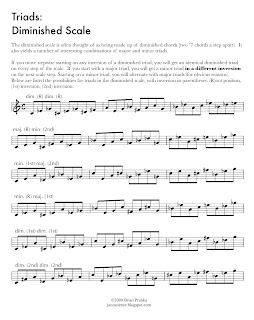To get a better grasp on the device, I took it out of the context of the chord progression and planed the arpeggio diatonically through the major scale. This would also work on any mode of the major scale (dorian, phrygian, lydian, mixolydian, aeolian, locrian), since they all have the same chords.
This could work well in a modal tune like "Milestones", which is a long dorian vamp followed by an aeolian bridge.
The arpeggio is 1-5-7-10-13-14 (10-13-14 being 3-6-7, but up an octave). Rosenwinkel plays them alternating between the ascending and descending version. This works out two ways, depending on whether you start ascending or descending.
Since this is an arpeggio, there are many ways to modify it and come up with different results. Here are two obvious ones: omitting the root of each arpeggio (which gives you a five-note pattern, creating rhythmically interesting results), and omitting both the root and fifth of each arpeggio (which creates a quartal sound with an interesting ambiguity).
All of these can be played with different rhythmic permutations.
The 5-note pattern is creates interesting cross-rhythms when played as 8th notes or triplets.
The 4-note pattern is more interesting as triplets.
Any triplet pattern can be played with accents on the 8th-note triplet or on the quarter note triplet. Especially on the original 6-note pattern, I like to mix up the two kinds of triplet accents.





